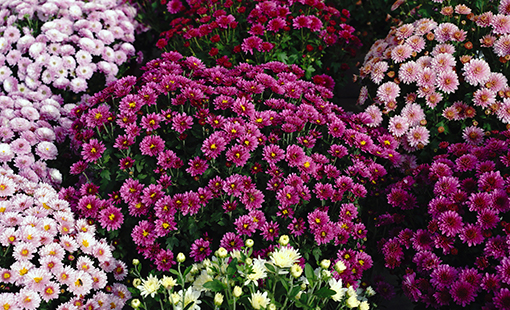
Hardy Mums Care & Info
Hardy mums are valued in landscaping because they bloom primarily in the fall, helping you to achieve four-season interest in your yard. They’re also a favorite of florists for arrangements, thanks to the longevity of their blooms. They not only come in a wide array of colors, but they also have different flower forms and growth habits. For instance, the popular “cushion” type has a compact growth habit. The shape and arrangement of the petals of a mum’s blooms can also vary from group to group. The most popular flower form is the “decorative,” which is so packed with long, broad petals that you can hardly see the center. The foliage on the plants is generally a dark green.
Outside of their growing zones, hardy mums are often treated as annuals, planted in the fall already in bloom for a pop of color and then discarded once the cold weather starts to depreciate their foliage and blooms. But if you plan to keep your mums as a perennial, plant seeds in the early spring or in the fall at least six weeks before your area’s first hard freeze. Hardy mums are fast-growing and will reach their full height within their first year, with the plant filling out a little more each subsequent year.
Care
Mums are a bit fussy about their growing conditions. It’s important to know exactly which cultivar you’re working with because their care needs can slightly vary. For perennial growth, it’s recommended to order your plants from a catalogue, which should detail the cultivar’s specific needs. For annuals, most hardy mums can tolerate slightly less-than-ideal conditions for just one season.
Be sure to plant your mums in a site that’s protected from damaging strong winds. But provide them with good air circulation around the plants, which can help to reduce the risk of disease, such as fungal infections. Overall, hardy mums typically don’t have any serious pest or disease issues. Plan to water and feed your mums regularly. And in the spring and summer, do some light pruning to encourage bushier growth. In the fall, your hard work will pay off with a plethora of bright blooms.
Light
Hardy mums prefer to grow in full sun, meaning at least six hours of direct sunlight on most days. However, in the warmer parts of their growing zones, they can benefit from some afternoon shade. The flowers are photoperiodic, meaning they bloom in response to the shorter days and longer nights experienced (in the northern hemisphere) in the late summer and fall. Therefore, don’t plant them near street lights or night lights; the artificial lighting can wreak havoc with their cycle.
Soil
These plants grow best in organically rich soil with a slightly acidic to neutral soil pH. Sharp drainage is a must, as soil that remains wet for too long can rot their roots.
Water
Mums like consistent moisture but not soggy soil. Water whenever the soil dries out about an inch or two down. In warmer weather and once the plant is large and in bloom, more frequent waterings will likely be necessary.
Temperature and Humidity
As their common name suggests, hardy mums are hardy both to cold and heat. They can handle temperatures up to 100 degrees Fahrenheit, though they’ll need sufficient water and some shade in those conditions. Likewise, they can survive temperatures down to around 20 degrees Fahrenheit. In cold climates just outside of their growing zones, they sometimes can survive winter if the roots are protected with a layer of mulch or straw. Leaving the degraded foliage in place over winter also can help to insulate the roots. A moderate humidity level is ideal for these plants.
Fertilizer
Mums are fairly heavy feeders. You can use a slow-release fertilizer in the spring, following label instructions. Or use a water-soluble fertilizer monthly through July. Any fertilization after July can trigger tender new growth that cold fall temperatures can damage.
Pruning
Pinching hardy mums (removing the tips of new growth, thereby stimulating the plants to send out side shoots) requires more maintenance than any other aspect of caring for them. But it’s worth it because pinching yields compact, bushy plants with profuse blooms. Start pinching in the spring when the new growth has reached roughly 6 inches long. Every two to three weeks, pinch back half of any new growth when it reaches 6 inches. Stop pinching chrysanthemums around the beginning of summer or else bud formation won’t occur soon enough to ensure flowering for fall.
Information courtesy of TheSpruce.com

 Adams Fairacre Farms
Adams Fairacre Farms